Strategic Sector
Enhancing Advanced Materials Science and Life Science Toward Innovations using New Light Sources, Including State-Of-Art Laser Technology
Research Supervisor
Outline of Research Area

Tadashi Itoh
Osaka University
Institute for NanoScience Design
Professor
The present research area aims at accelerating collaboration and fusion of potential research and development (R&D) capacities related to light utilization science and optical technologies that currently are individually investigated in different fields such as substances and materials; processing and measurement; information and communication; environment and energy; and life sciences, so as to build up foundations for creation of a innovative new stream for “relation of materials to photons” in the field of optical science and technology.
At present, various types of advanced light sources represented by high performance, state-of-the-art lasers are widely available, leading to rapidly increasing numbers and extent of research projects performed for investigation of their usage. However, since the advanced light sources are placed into black boxes, these light sources are not always utilized to the extent of their maximum potential. Taking these circumstances into account, the present research area promotes distinguished research regarding “relation of materials to photons” in which characteristics of light sources are extremely utilized.
Furthermore, this research area covers leading research that will enable achievement of breakthroughs in the field of light utilization science and technology, and also includes objective-oriented basic research in a wide range of fields such as life sciences and environmental and energy. It should be noted that this research area puts special importance on seeds that will create research aimed at fusion of advanced optical science and optical technology as well as at creation of a novel stream, e.g. by showing truly effective methods of making extreme use of state-of-the-art light sources such as lasers. In these research projects, analyses of events or identification of principles do not mean the end of the research, but instead how these technologies can be put to practical use will always be taken into account. The present research area does not aim at the world record of the light source performance itself but includes research that identifies any relevant and advanced need regarding the light source required for research processes and provides feedback on such needs to the light source development research, contributing to practical advancement of optical utilization science and optical technology fields.
Research Supervisor’s Policy on Call for Application, Selection and Management of the Research Area
Today, rapidly developing optical technology is spreading and expanding as an important social infrastructure with the deepening and expanding of our understanding of optical science, and not only is it a useful tool in the industrial world, it plays a role as the base for creating innovation. In order to dramatically advance the optical science and technology necessary for our country’s manufacturing industry, medicine, and the environment, this research area takes the initiative in promoting the utilization and R&D of optical science and technology, with “the relationship between material and light” as the key phrase. Through this, we aim to create technological innovation that will have a pervasive effect on practical use.
Our recruitment policy for this fiscal year will welcome research that controls the performance of cutting-edge light sources to the limit and contributes to innovation. The past two years, the research we adopted centered on more academic themes, such as measurement and imaging, substances and materials, and quantum manipulation. However, this year, we are looking for research that is more task-driven or more technical in nature, particularly research adopting and making full use of advanced light sources to tackle important and urgent issues faced by the human race, such as environment, energy creation and saving, low-carbon emitting society, and information processing and communication. All research proposals should have an active and challenging target, provide the current direction and supporting data, specifically state the annual targets for the entire plan and the cooperative structure between researchers, and provide a specific aggregate roadmap leading to the final goal.
Our selection policy this year will be to conduct relative evaluation based on such points as to whether the direction of the research can be linked to industrial and social needs, whether it is an issue that needs to be resolved now, or whether it is an original idea that provokes true astonishment. Additionally, we will also consider whether the research aims to lead the world, whether the research structure is fusional, whether the idea will spread to other areas, and whether it will create the seeds of technology that are long lasting. The research fund classification requires that Class II (average 400 million yen) research proposals provide results that are more practical or meet more precisely the expectations of society than the Class I (average 200 million yen) research proposals. We expect proposals for research that do not just depend on the performance of commercially available advanced light sources, but instead, through synergy between practical use researchers and development researchers, create new seeds of technology that cannot be achieved individually.
As for the management of this research area, we will promote the active exchange of ideas and technology between the research issues in the area as well as work to develop innovative research by actively cooperating with Photon Frontier Network Program conducted by the Ministry of Education, Culture, Sports, Science and Technology.
